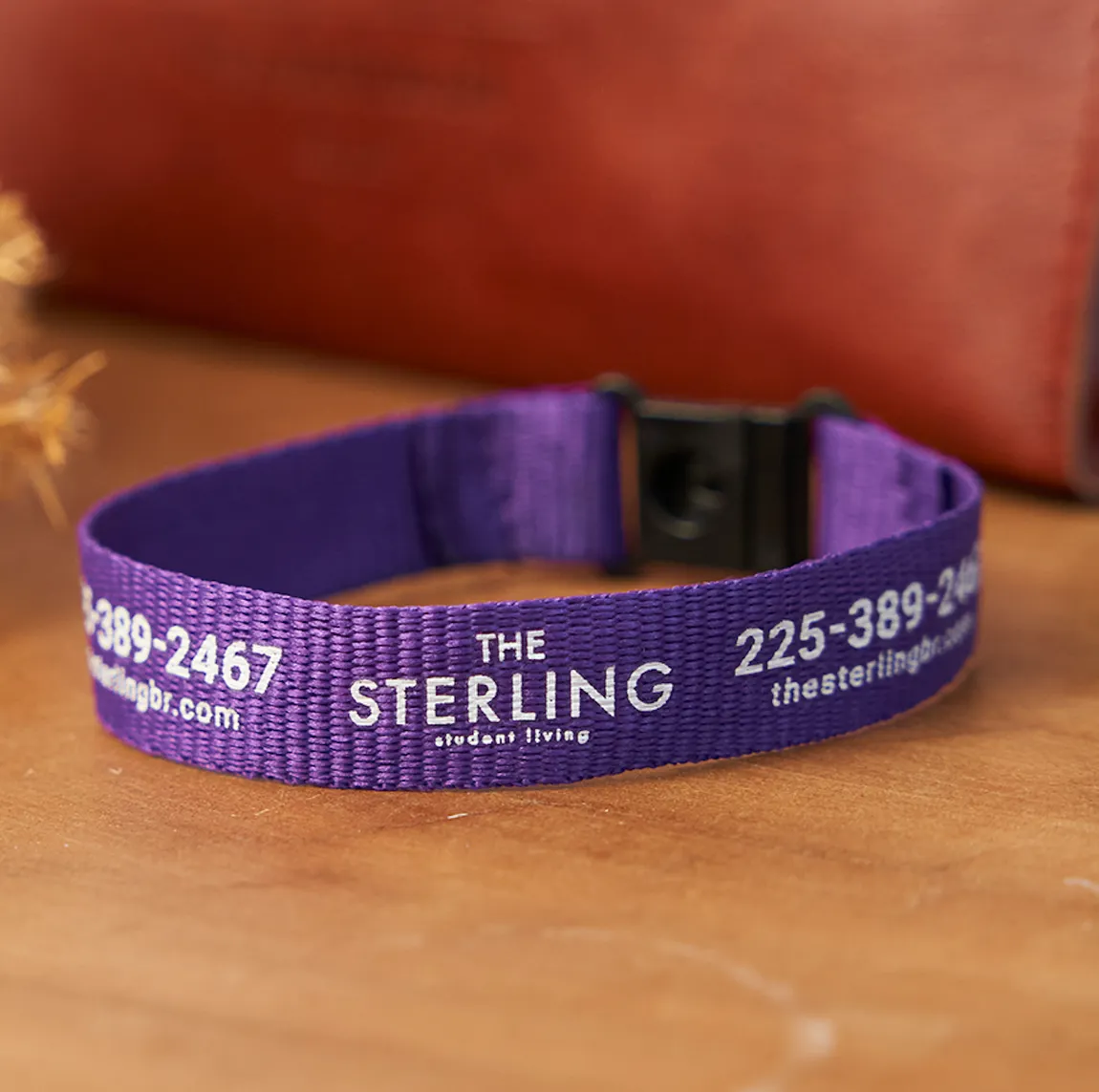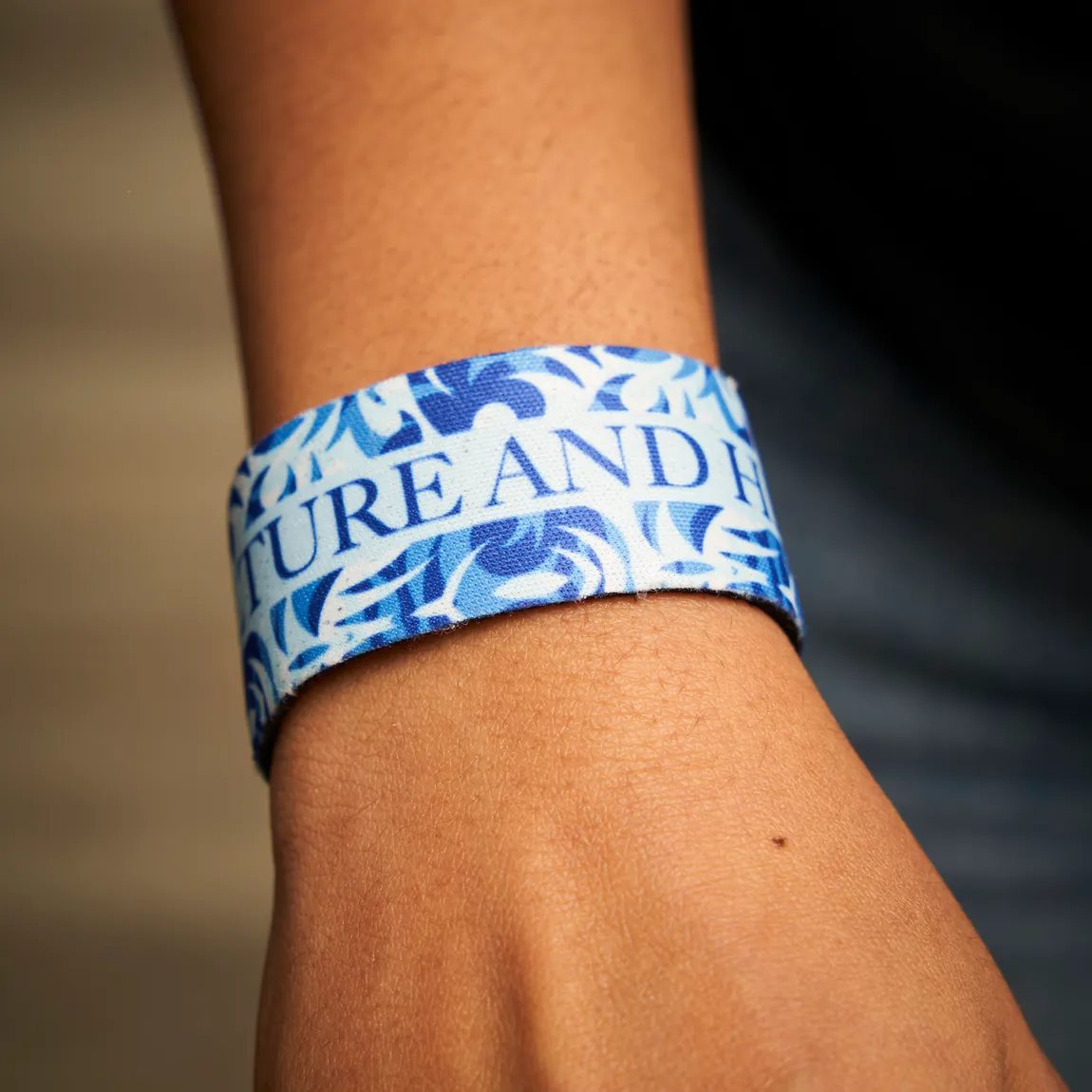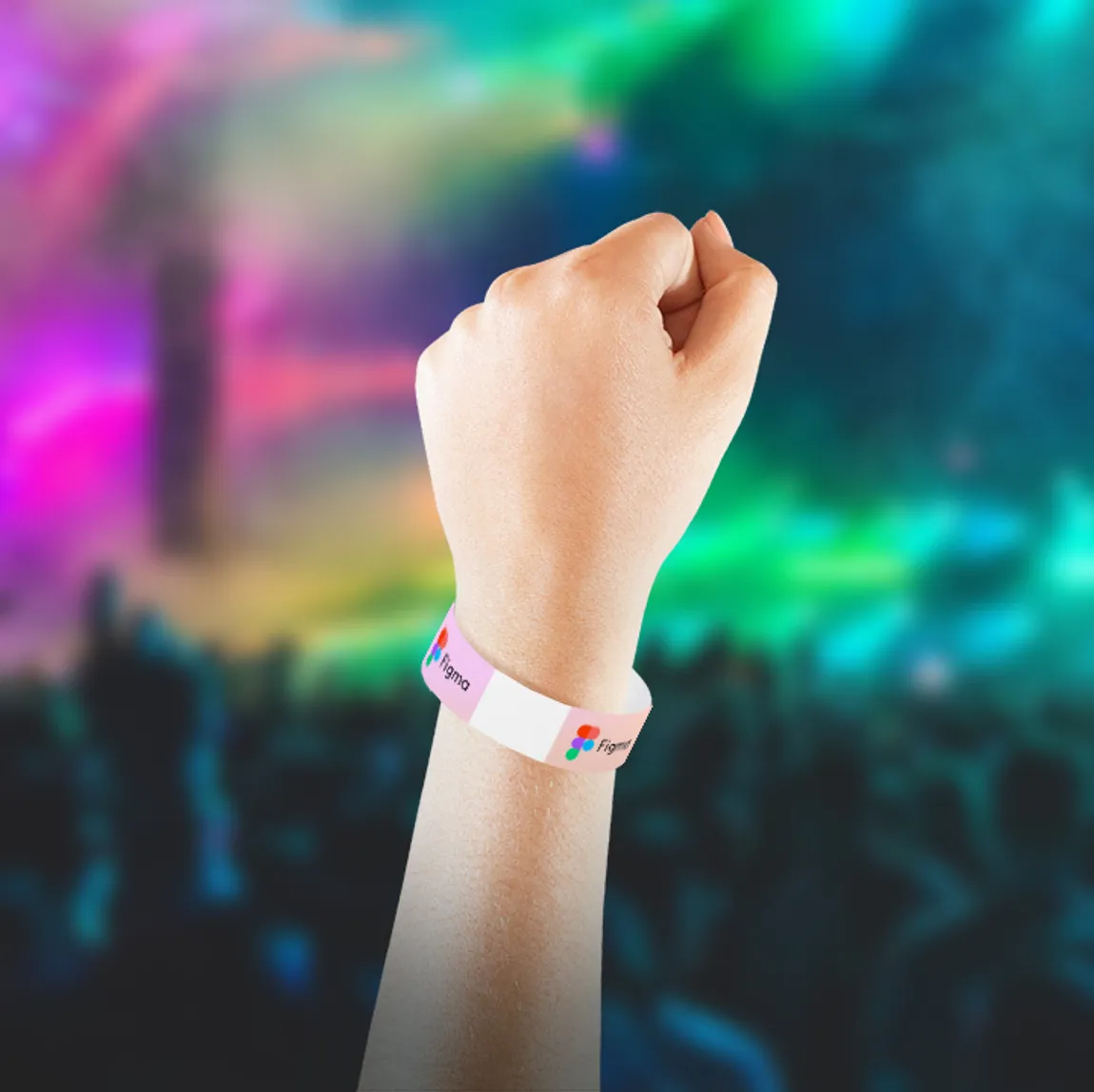Choosing the right wristband for your event or organization can be challenging, especially when deciding between vinyl and cloth wristband types. Each type offers unique benefits and features that cater to different needs and preferences.
This guide will help you understand the key differences, advantages, and considerations so that you can make an informed decision that best suits your requirements.
How Do Vinyl and Cloth Wristbands Differ in Material?
Vinyl and cloth wristbands are made from distinct materials, each offering unique characteristics that cater to different needs and preferences. Understanding these differences can help in making an informed decision.
Vinyl Wristbands
- • Material Composition: Vinyl wristbands are made from a type of plastic known as polyvinyl chloride (PVC). This material is known for its durability and resistance to wear and tear.
- • Texture and Feel: The surface of vinyl wristbands is smooth and slightly glossy, providing a sleek appearance.
- • Weight: Vinyl wristbands are lightweight, making them comfortable for single-day events, although they may feel less flexible compared to cloth options.
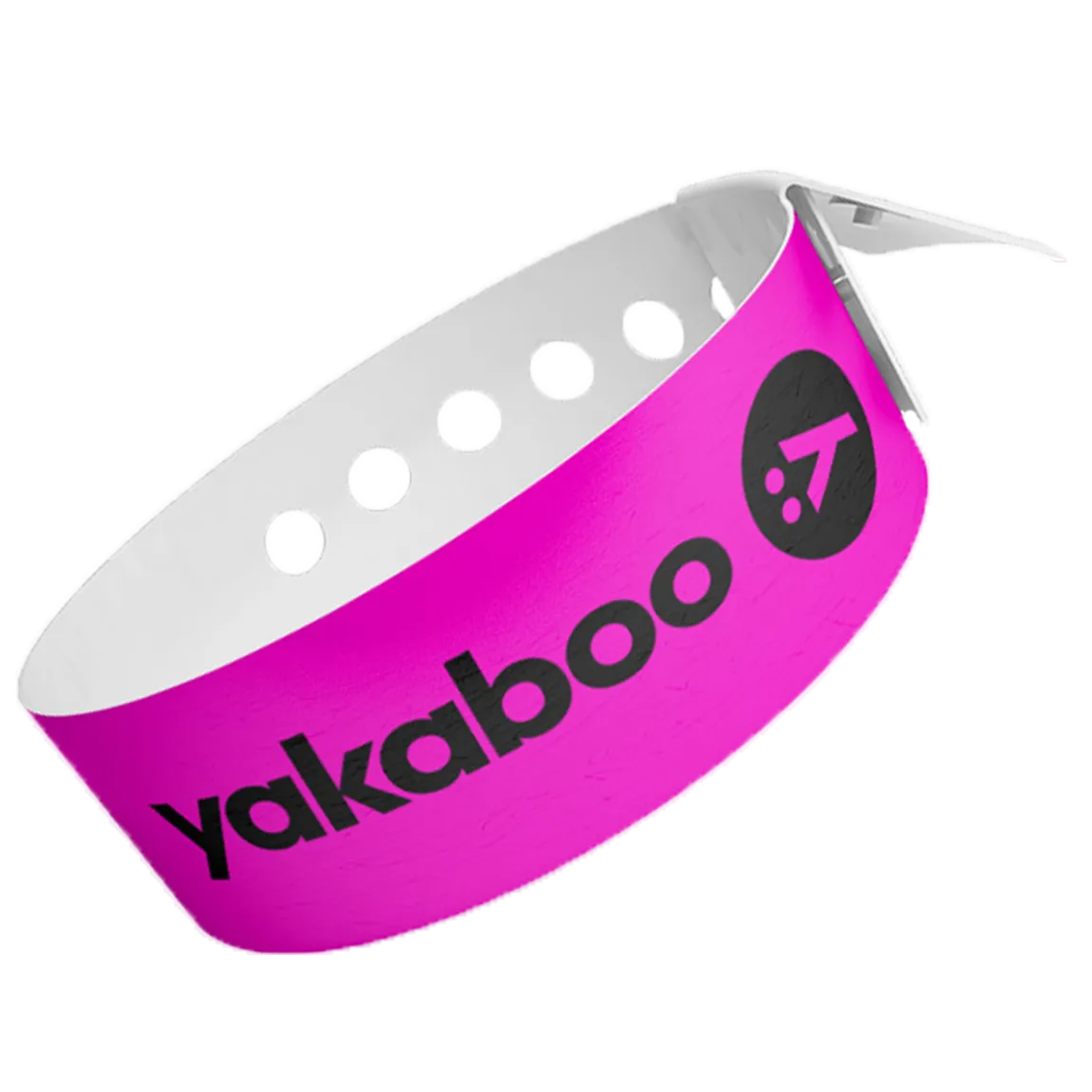
Create a unique experience with custom vinyl wristbands
Cloth Wristbands
- • Material Composition: Cloth wristbands are typically made from woven fabric, such as polyester or cotton. These materials are chosen for their softness and flexibility.
- • Texture and Feel: Custom cloth wristbands have a soft, fabric-like texture with a satin finish that is gentle on the skin. They are more flexible than vinyl, allowing for a snug yet comfortable fit.
- • Weight: Fabric wristbands are also lightweight, but their satin finish provides a natural feel, ideal for multi-day events or birthday parties.
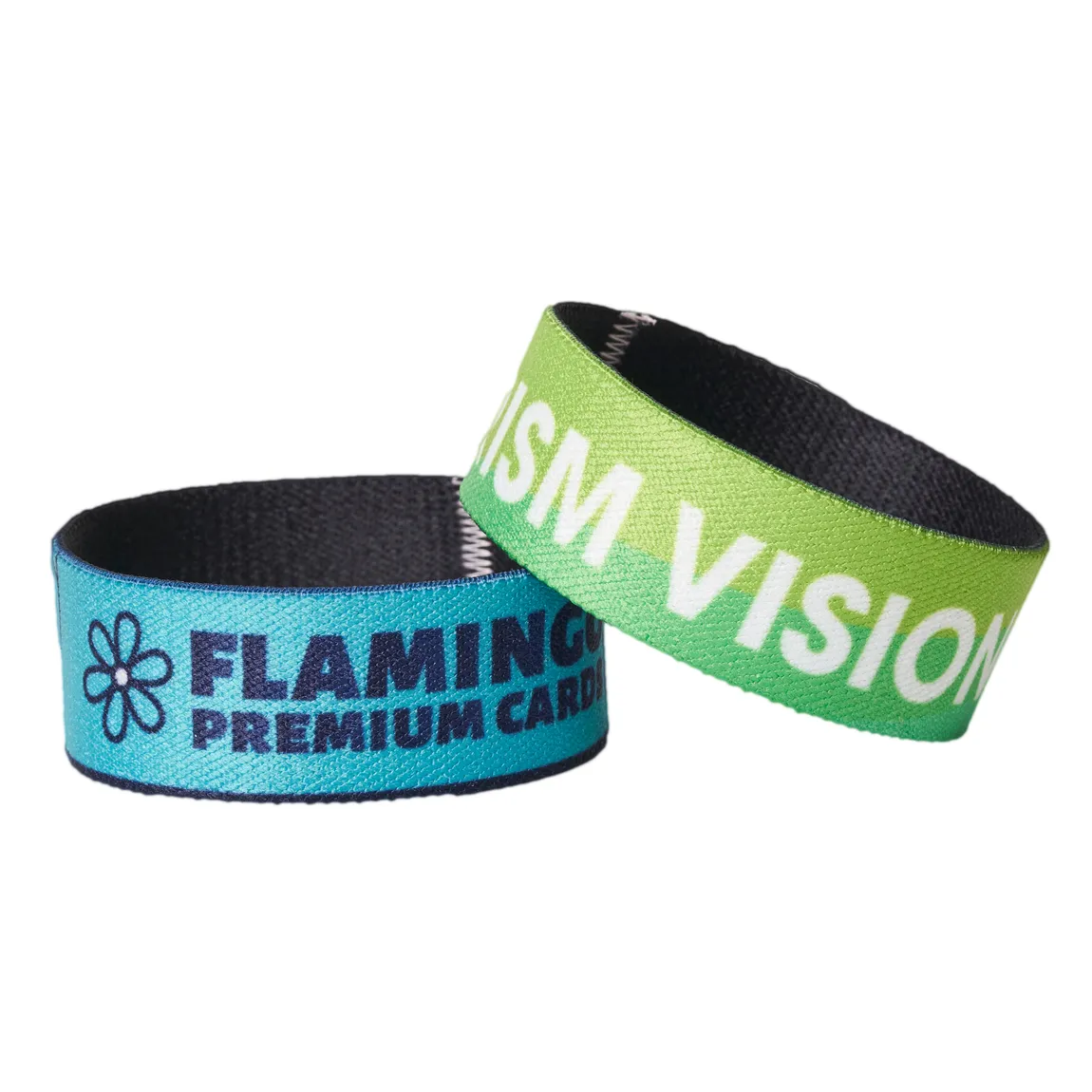
Elastic wristbands for dynamic events
These material differences influence the wristbands' look, feel, and suitability for various applications, such as access control at swimming pools, promotional activities, or extended wear across multiple days.
How Long Do Vinyl Wristbands Typically Last?
Vinyl wristbands are known for their durability and longevity, making them popular for events requiring extended use. On average, they can last one to two weeks, depending on the conditions of multi-day events.
Several factors contribute to the lifespan of vinyl wristbands:
Material Composition
Vinyl wristbands are made from a strong, flexible plastic material that is resistant to tearing and stretching. This composition allows them to maintain their integrity over time, even with frequent use.
Environmental Resistance
Vinyl wristbands are designed to withstand various environmental conditions. They are water-resistant, making them suitable for events where exposure to moisture is likely. Additionally, they can endure exposure to sunlight without significant degradation, although prolonged exposure may eventually lead to some fading.
Wear and Tear
Vinyl wristbands' durability also depends on the level of physical activity and handling they are subjected to. While they are robust, excessive pulling or twisting can reduce their lifespan. However, they remain intact and functional under normal conditions for most events.
Closure Mechanism
Vinyl wristbands typically feature a secure snap closure that prevents accidental removal, ensuring they stay firmly in place during activities at your next event. This closure system enhances security and contributes to the wristband's longevity by ensuring it stays in place without loosening.
Vinyl wristbands are a reliable option for events lasting several days to a couple of weeks. Their resistance to environmental factors and robust construction make them practical for indoor and outdoor use.
|
Layered Wristband Use: Use vinyl and cloth wristbands together to denote different access levels or groups. |
Are Cloth Wristbands More Durable Than Vinyl Ones?
Cloth wristbands are often praised for their durability, making them popular for events requiring long-lasting wear. Here are some key points to consider regarding the durability of woven cloth wristbands compared to vinyl ones.
Material Strength
Cloth wristbands are typically made from woven fabric, which provides a strong and resilient structure. This material can withstand significant wear and tear over time.
Resistance to Fraying
Woven fabric wristbands are designed to resist fraying, even with extended use. The edges are often heat-sealed or finished to prevent unraveling, ensuring the wristband maintains its integrity.
Color Retention
Cloth wristbands are known for retaining color, even after exposure to sunlight and repeated washing. This makes them ideal for events where the wristband needs to remain vibrant and legible throughout its use.
Flexibility and Comfort
Cloth wristbands' flexibility contributes to their durability. They can stretch slightly without losing shape, which helps them endure physical activities without damage.
Environmental Factors
Cloth wristbands are generally more resistant to environmental factors such as moisture and temperature changes. They dry quickly when wet and do not become brittle in cold weather.
Cloth wristbands offer a durable solution for events requiring long-term use. Their resistance to fraying, color retention, and ability to withstand environmental challenges make them a reliable choice for many applications.
Which Type Of Wristband Is More Comfortable For Long-Term Wear?
When considering wristband comfort for long-term wear, several factors include flexibility, breathability, and the potential for discomfort. Both vinyl and cloth wristband types have distinct characteristics that affect their comfort levels.
Flexibility
Vinyl wristbands are generally less flexible than cloth wristbands. They are made from a durable material that can feel rigid, especially when worn for extended periods. This rigidity may lead to the discomfort of the guests if the wristband is too tight or does not conform to the wrist's shape.
Custom cloth wristbands, on the other hand, are typically more flexible. They are made from woven materials that stretch slightly and adapt to the wrist's contours, providing a more comfortable fit for event wristbands.
Breathability
Vinyl wristbands are not as breathable as cloth wristbands. The material can trap heat and moisture against the skin, which may lead to sweating and discomfort, particularly in warm environments.
Cloth wristbands offer better breathability due to their woven structure. This allows air to circulate more freely, reducing the likelihood of sweating and making it more suitable for long-term wear in various conditions.
Potential for Discomfort
Vinyl wristbands can sometimes cause skin irritation, especially if worn tightly or the wearer has sensitive skin. The edges of vinyl wristbands may also dig into the skin, causing discomfort over time.
Cloth wristbands are generally softer and less likely to irritate. The fabric is gentle on the skin, and the absence of sharp edges makes it a more comfortable option for prolonged use.
When evaluating wristbands for long-term comfort, cloth wristbands offer greater flexibility, breathability, and a reduced risk of irritation compared to vinyl wristbands. These factors make cloth wristbands preferred for those seeking comfort during extended wear.
|
Allergy Testing Tip: Test a sample on sensitive skin before large-scale distribution to avoid irritation complaints. |
Are There Any Skin Irritation Concerns With Either Type?
When considering wristbands for events or personal use, it is important to address potential skin irritation concerns associated with both vinyl and cloth wristbands. Understanding these concerns can help make an informed decision prioritizing comfort and safety.
Vinyl wristbands are generally made from PVC (polyvinyl chloride), which can sometimes cause skin irritation, especially for individuals with sensitive skin.
The following factors may contribute to irritation:
- • Allergens: Some vinyl wristbands may contain latex or other allergens that can trigger reactions.
- • Sweat Accumulation: Vinyl is less breathable than cloth, which can lead to sweat accumulation and discomfort, particularly in hot or humid conditions.
- • Chemical Residues: Manufacturing processes may leave chemical residues on the wristbands, irritating the skin.
To minimize these risks, it is advisable to choose hypoallergenic vinyl wristbands and ensure they are free from latex and other common allergens. Additionally, selecting wristbands with a smooth finish can reduce friction against the skin.
On the other hand, woven cloth wristbands are typically made from fabric materials such as polyester or cotton. These materials are generally more breathable and less likely to irritate.
However, there are still some considerations to keep in mind:
- • Fabric Dyes: Some fabric wristbands may use dyes that can cause allergic reactions in sensitive individuals.
- • Fraying Edges: Poorly finished edges can cause chafing or irritation over time.
- • Moisture Retention: While more breathable, cloth wristbands can retain moisture, which may lead to discomfort if worn for extended periods.
To address these concerns, it is recommended that cloth wristbands be chosen with high-quality, non-toxic dyes and well-finished edges. Opting for wristbands with moisture-wicking properties can also enhance comfort.
Both vinyl and cloth wristband types have potential skin irritation concerns, but these can be mitigated by selecting high-quality products and considering individual skin sensitivities.
Which Wristband Is Better Suited For Outdoor Events?
When selecting wristbands for outdoor events, it is important to consider how each type performs under various environmental conditions. Vinyl and cloth wristbands have distinct characteristics that make them suitable for different outdoor settings.
Vinyl Wristbands
- • Sunlight Resistance: Vinyl wristbands are generally resistant to fading when exposed to direct sunlight, making them a reliable choice for events held in sunny conditions.
- • Water Resistance: These wristbands are waterproof, which means they can withstand rain or splashes without deteriorating. This feature particularly benefits events near water or areas prone to sudden weather changes.
- • Durability: Vinyl wristbands are less likely to accumulate dirt and grime, maintaining their appearance throughout the event.
Cloth Wristbands
- • Breathability: Cloth wristbands offer better breathability, enhancing comfort during long outdoor events, especially in hot and humid climates.
- • Moisture Absorption: While not waterproof, cloth wristbands can absorb moisture, which may be advantageous in preventing sweat accumulation on the skin.
- • Aesthetic Appeal: Cloth wristbands often provide a more premium look and feel, which can be desirable for upscale outdoor events or festivals.
When choosing between vinyl and cloth wristbands for outdoor events, consider the specific environmental conditions and the desired balance between durability, comfort, and appearance. Each type offers unique advantages that can cater to different event needs.
|
Batch Color Coding: Use distinct colors or patterns for different event days to simplify access control. |
How Secure Are Vinyl Wristbands Compared To Cloth Ones?
Vinyl and cloth wristbands offer distinct security features catering to different needs. Understanding these features can help you select the most appropriate wristband for your event or purpose.
Vinyl Wristbands
- • Tamper-Evident Closures: Vinyl wristbands often come with snap closures designed to be tamper-evident. Once fastened, these closures cannot be removed without breaking, making it clear if someone has attempted to tamper with the wristband.
- • Serial Numbering: Many vinyl wristbands can be customized with unique serial numbers. This feature enhances security by allowing event organizers to track and verify each wristband individually.
- • Barcoding: Some vinyl wristbands can be printed with barcodes, which can be scanned for quick and accurate identification. This is particularly useful for events with large crowds where rapid verification and crowd control are necessary.
Cloth Wristbands
- • Secure Locking Mechanisms: Cloth wristbands often use adjustable locking beads or sliding locks that secure the wristband in place. These mechanisms prevent removal without cutting the band, ensuring the wristband remains intact throughout the event.
- • RFID Technology: Cloth wristbands can be embedded with RFID (Radio Frequency Identification) chips. This technology allows contactless scanning, providing high security and convenience for access control and cashless transactions.
- • Custom Weaving: The ability to weave intricate designs and logos directly into the fabric of cloth wristbands makes them difficult to replicate, adding an extra layer of security against counterfeiting.
Both vinyl and cloth wristbands offer robust security features, but the choice between them depends on your event's specific requirements. Vinyl wristbands are ideal for tamper-evidence, and quick visual verification is a priority.
In contrast, cloth wristbands are better suited for events that require advanced technology like RFID and a higher level of customization to prevent counterfeiting.
Choose the Ideal Wristband for Your Event
Choosing between vinyl and cloth wristband types depends on your needs, such as durability, comfort, cost, and environmental impact.
Vinyl wristbands are water-resistant and durable, making them ideal event wristbands for short-term events or admissions, such as water parks or conference venues.
Fully adaptable and fully customizable, these custom wristbands are an excellent choice for multi-day events, promotional activities, and upscale birthday parties. Their breathability and premium design ensure attendees remain comfortable while showcasing your branding.
Consider your audience, event type, and priorities, then confidently make your choice. Ready to elevate your event experience? Discover our wide selection of wristband types today!
Customize your design, maximize comfort and functionality, and leave a lasting impression on your attendees. Order now and make your event unforgettable!

/filters:quality(80)/fit-in/630x380/blog/image-1738208999.png)
